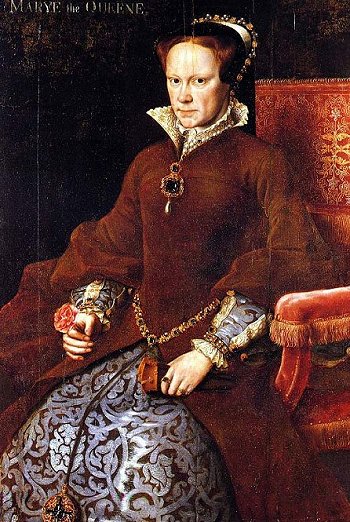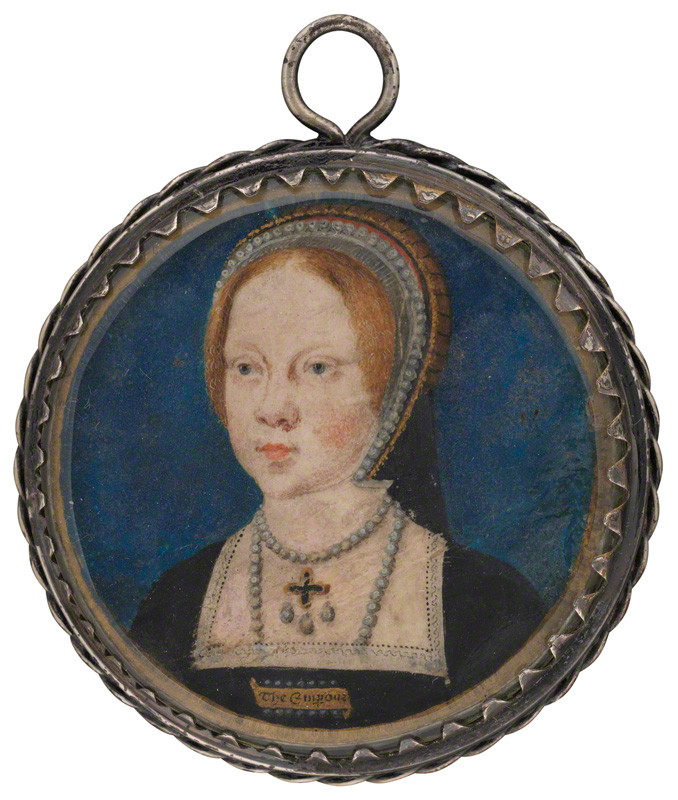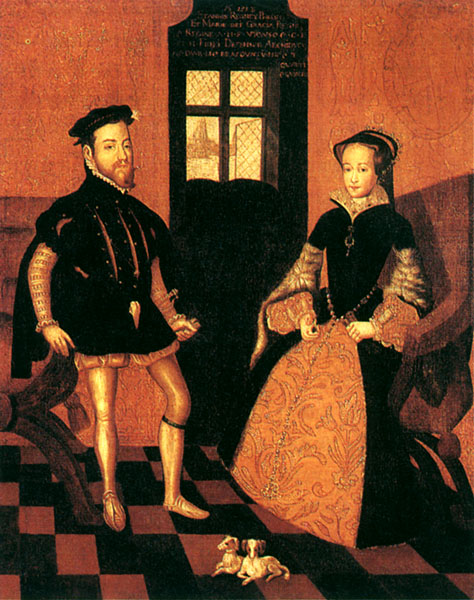Queen Mary I of England is best known for burning people of the Protestant faith and restoring England to Catholicism. She was given the nickname “Bloody Mary” because of her constant executions of Protestants. Mary reigned over England from 1553 to 1558.
Mary Tudor was born to parents Henry VIII and Catherine of Aragon on February 18, 1516 in Greenwich palace. She was their only child to live through childhood and infancy. As a young girl, she lived a comfortable life as princess. At the young age of six, she was already betrothed to Charles V, but three years later the betrothal was broken off. However, Henry was angry that Catherine had not given him a son that survived past infancy. So, their marriage was annulled and Mary was declared illegitimate when Henry married Anne Boleyn in 1553. Anne was unable to give Henry a son either, though she did give birth to a daughter they named Elizabeth.
On January 7, 1536, Catherine of Aragon passed away from unknown causes, though rumour was that she was poisoned. After the annulment of her marriage with Henry, Mary was prohibited from speaking or writing to her mother. Mary was forced to leave her mother at a young age and move in with her half-sister Elizabeth and step-mother. Anne was also pregnant again, though Henry planned to execute or punish her if she did not give birth to a son. She ended up suffering through a miscarriage and was later executed in May of 1536.
Her father finally got what he wanted when he married his third wife, Jane Seymour: a son named Edward. Of his seven wives, she was the only one to give birth to a son that lived through childhood. When Henry died in 1547, Edward VI became King with Mary as his successor and Elizabeth following Mary.
For six years, Mary’s half-brother was king until his death in 1553. Mary was no longer his successor though because she, unlike her brother, was not Protestant and wished for England to return to the Church of Rome. Lady Jane Grey, Henry’s niece, was named Edward’s successor instead. Jane ruled for only nine days though.
Mary was soon declared as the rightful queen on July 19, 1553 and left for London on July 24 after spending some time in Framlingham. She officially entered London September 30, 1553 with her sister Elizabeth and Anne of Cleves, Henry’s only wife that survived past his death, with her. On October 1st, Mary was coronated and crowned Queen of England.
After reigning for only a few days, Parliament held its first meeting with their new queen. Mary quickly passed an act that stated that her parents marriage was valid. Also, Mary had an act passed that repealed the religious laws her father had set. Unlike the former, the latter act took quite some time to get passed through Parliament.
Soon, Mary began to search for a suitable husband. Many speculated and hoped she would marry one of the few descendants of the House of York, Edward Courtenay. Instead, Mary married Prince Philip of Spain, the son of her cousin Emperor Charles V. He had proposed that Mary and his son wed, and Mary eventually agreed. The public was not a huge fan of Mary’s choice in a husband though.
There were four plots in total around this time to get Mary off the throne. So, Mary hung 100 rebels and pardoned 400 others that were involved in these plots. Elizabeth and Edward Courtenay were both imprisoned in the tower because the public had wished for them to rule, not Mary. Lady Jane Grey and her husband were also executed.
Mary and Prince Philip met for the first time on July 23, 1554 and were married two days later. A physician of Mary’s declared her pregnant that September after she had showed many signs and symptoms of pregnancy.
Shortly after being declared pregnant, Mary set to work on returning England to Catholic faith. In January of 1555, John Cardmaster, John Hooper, and John Rogers were all arrested because they refused to join the Catholic church. The three of them were to be executed by being burnt at the stake. Mary continued executing Protestants, leading to the public’s hatred of her. Eventually, Mary would have about 275 people executed because of their refusal to stop practicing their faith as Protestants. This earned her the nickname “Bloody Mary”.
Before leaving for France, Philip and Mary got to work on deciding who their successors were if she was to die at childbirth, which was quite common. If it did happen, Philip would be regent. Mary did not want Elizabeth in line for the throne due to her faith, so Mary Queen of Scots fell in Elizabeth’s place instead. Philip suggested to Mary that Elizabeth marry the Duke of Savoy who was of Catholic faith. Mary refused though.
When July came around, Mary was prepared to go into labor. No child was came even after they continued to push the date back. There are many different theories as to why Mary never had the child. Perhaps she had miscarried or went through a phantom/false pregnancy, meaning she went through all the symptoms of a pregnant woman but never actually carried a child. Mary was noted to have longed to have a child of her own, but she never did.
Philip left England the following month. Mary was said to have been very in love with her husband. When he left, she fell into a state of sadness and depression. It most likely didn’t help that she had wished for a child and turned out to never have one.
While he was gone though, Mary continued burning and executing Protestants. Philip would not return home to Mary until March of 1557. England went to war with France not long after Philip’s return, and he left England once more to lead his men into battle.
Once again, Mary was thought to be pregnant after her husband had returned home for a short period of time. This time she was sure of it, though many people had a feeling she would not have the child, just like last time. When no child was born by the following April, Mary knew she would not be able to have a child.
After the second false pregnancy, Mary began to feel ill. Her health continued to get worse and worse, leading to her death. On November 17, 1558, Mary died at the age of forty-two at St. James Place. In Mary’s will, she stated she would be buried with her mother. Elizabeth had her interred in a tomb at Westminster Abbey. When Elizabeth passed away, she was placed in the same tomb as Mary.




